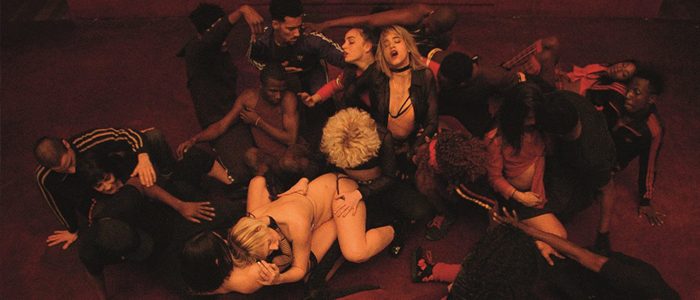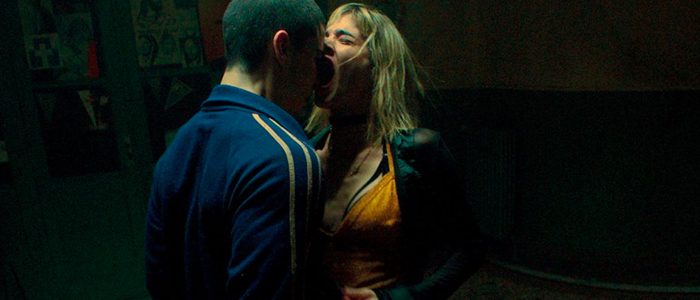
Climax is a tragedy in the form of intoxicating sensory experience. An allegory for the collapse of modern society, as several critics have noted, Gaspar Noé’s dance-infused explosion of warring psyches and writhing bodies (backed by the French tricolor) may be, at once, his most abstract work and his most direct. It pulls from a career’s worth of cinematic ticks and eccentricities, spackling them with dance electronica from wall-to-wall — Thomas Bangalter of Daft Punk even recorded new music for it — creating an audiovisual tapestry that’s equal parts haunting and exhilarating, as if the ghost of Oscar from Enter the Void decided to stick around the club he died in and watch the end of the world.
The film begins at the story’s close (parting shot, credits and all) before winding back to a more innocent time, before its two dozen or so multi-ethnic European dancers had come into contact with one another, or with the (allegedly) LSD-spiked sangria that would eventually unravel them. A24’s trailer for the American release gives you a good idea of what their intros look like. Bound by the narrow walls of an old television screen, they’re told to speak honestly about their dreams and desires as their troupe heads for America and for limitless opportunity — the film seems winkingly set before the madness of the current era — but they still hold something back. It isn’t until this screen is widened and they’re allowed to stand shoulder to shoulder in the wings of their rehearsal space that their true feelings come to light, as Noé turns the very idea of post-rehearsal ego and tension into a erotic sensory experiment.
But first, they dance.
We’re re-introduced to the dancers as a pulsating collective (with Sofia Boutella’s Selva as the centerpiece), shedding their inhibitions and embracing the palpable sexual energy they share. The film could’ve been a 90-minute dance scene and it would’ve still been worth the time, given Noé’s clear love for the art form and the manic verve with which he captures it, but he isn’t content with simply seeing what happens when these performers let their guard down. As soon as the music stops (or rather, transitions to something more relaxed; the music never ceases), the walls come right back up as the dancers pair off into their little cliques, drinks in hand, complimenting each other in ways that might not be entirely honest before slowly and stealthily setting up future conflict.
One pair of performers discusses the child on the premises, the troupe choreographer’s son who comes dangerously close to the proceedings. Another sees two men puffing their chests, gleefully discussing how they’d coax their female teammates into sleeping with them; it sounds distinctly rape-y. Elsewhere, two women eye both sexual and physical prey, ready to attack one of their teammates at a moment’s notice; it seems like mere banter, at least at first. Two other men — both gay, an older bear and a virgin twink — discuss sex more playfully and tenderly. Off on the couch, a trio indulges in more vulnerable chatter about love and relationships. A brother and sister even argue over their dating lives, with a more uncomfortable tension between them.
Every character feels fully fleshed out during this section, despite mere minutes of screen time. Noé blinks between the groups like he’s switching channels, but each vignette is tethered to the rest by the party music off in the distance (you can tell how far they are from the speakers, and from each other) so when the performers finally return to the dancefloor, they no longer feel like a group of amorphous dancers. They’re now a community of individuals, each with their own vices and insecurities that bounce off one another in the form of performance. During their second dance — more self-indulged celebration than dedicated rehearsal — we watch them from above, like a helpless God observing over the hedonistic proceedings, as they take turns dancing in the center of a human circle, expressing, through movement, the individual energies we’ve just seen expressed through words.
This is both Noé’s mission statement — to capture the clash of egos through movement— as well as the last time any of the character’s expressions feels healthy. About thirty minutes in to the film, it’s time for the danvcers’ individually-stylized opening credits; this isn’t just a Gaspar Noé film. It’s a Gaspar Noé party, and it’s just getting started.
Benoît Debie’s camera follows the dancers, often one at a time (switching point-of-view by trading between them mid-movement) in long, snaking takes through the dimly lit hallways where they currently live. Their rehearsal space is surrounded by nothing but snow, so this dingy, neon residence may as well be the last place on Earth; when they begin experiencing the effects of whatever they’re been drugged with, it starts to feel like it, too. Their senses become heightened, as do their emotions, as the rest of the world fades away. They attack each other. They try to fuck each other. They gang up on those they suspect of having spiked the sangria, yet nobody seems willing or able to step outside the bounds of the sacred artistic space they share, condemned to act out against one another as they reveal their inner truths through action, as if we’re witnessing some fucked-up, violent, overtly sexual re-staging of Sartre.

The music grows darker, more haunting and more enveloping. Neon’s “Voices” follows the dancers are they traverse the halls in search of escape (or in search of each other) just as the lights go out and the backup generators wash the space in garish hues of red and green. Interestingly, this use of light and sound remains thoroughly objective. Each light source is a distinct, often visible part of the fiction. The music is diegetic blaring always from the speakers of “DJ Big Daddy,” the glue holding the company together. This is the world that we, even as neutral viewers, now inhabit, and should the dancers be experiencing some kind of hallucinations, we’d never really know. We’re not placed inside any one of their individual heads, which one would assume would be the M.O. of a film where LSD comes into play. However, the question of whether they were drugged at all feels right on the tip of the filmmaker’s tongues. It may be a direct story of dancers getting high and committing heinous acts, but then again, it may simply be the modern update to Luis Buñuel we didn’t know we needed, with something in the ether lowering their inhibitions to the point of terrifying honesty, preventing them from escaping each other’s orbits, sending them on a collision course with the worst parts of themselves.
Boutella’s Selva comes face to face with a wallpaper of a dead forest, with a long road paved between the leafless trees. We don’t see what she sees, but it stops her dead in her tracks. Before long, she’s trying to fuck the walls (the entire cast is fearless), as if the ideas of death and sexuality are so entwined for Noé that we’re compelled to project our own reasoning onto Selva’s actions. In effect, the onus of justifying the mayhem — pettiness and sexual impulse that grow to the point of violence — is on us.
The camera is often at a safe distance from Selva and from those around her, but certain punches, certain kicks and certain self-inflicted wounds become all the more horrifying given our inability to reach out and stop them. It’s we, the viewers, who end up filling the empty space between camera and character (or between characters and themselves, as they peer into mirrors, screaming in agony over some unseen horror) so perhaps we’re just as complicit as whoever spiked the sangria. These actions are, after all, grounded in the toxic social moorings that we’re collectively trying (and failing) to leave behind. They’re an extension of us.
There’s a thin line between life and death. For human beings, the former is tied up in animalistic impulse; the creation of life is an exquisite experience (so is death, per Noé’s title cards) so when the camera turns upside down, becoming subjective for the first time, it does so when the lights are at their reddest and most hellish, and when all the characters re-enter the rehearsal space and bring all their violent and sexual impulses with them. Every bit of their stories has, thus far, unfolded in isolation — an argument leads to a woman being set on fire, and you can bet those siblings fuck; it’s Gaspar Noé, after all — but when each impulse is allowed to turn up to eleven and the characters are allowed to invade and ravage one other, the subsequent explosion is one where sex and death seem indistinguishable. It’s one of the most unsettling depictions of Hell ever put on screen.
And it is Hell, mind you; each character is paying for their sins. Some, like the siblings in question, are even being compelled to act on their sins as punishment for the sins themselves, closing the loop between sex, violence and death that Noé has long been toying with as a filmmaker. It’s like watching an orgy turn into a street-fight, or vice versa; the film, at this point, becomes so visually chaotic that it’s hard to distinguish between the two. I’d be lying if I said it wasn’t alluring, but I’d also be lying if I said my own reaction didn’t make me squirm in my seat.
The energy of Climax is like few things ever put to screen. It cries havoc, letting slip the barely contained impulses that make up human beings and how we interact in society, collapsing the boundaries that keep the impulses within, letting them run wild as the world burns. The end of all things, this Hell we made for ourselves — the same Earthly Hell tipping Reverend Toller over the edge in First Reformed — never seemed so magnetic, or so fueled by adrenaline. Then again, it was never set to Cerrone’s “Supernature” either; good luck not thinking about sex and death and eternal damnation the next time you hear it.
But of course, as with any Gaspar Noé, comes the question: to what end? Without getting into spoiler territory, there’s an eerie calm that follows the events of Climax, along with a hint that this same madness is sure to be unleashed again, by our own hand. Humanity is going to keep experiencing Hells of its own making; we may as well enjoy the ride.
The post ‘Climax’ is Director Gaspar Noé’s Exotic Vision of Hell [Mumbai Film Festival] appeared first on /Film.
from /Film https://ift.tt/2T8qSOX


0 Comments